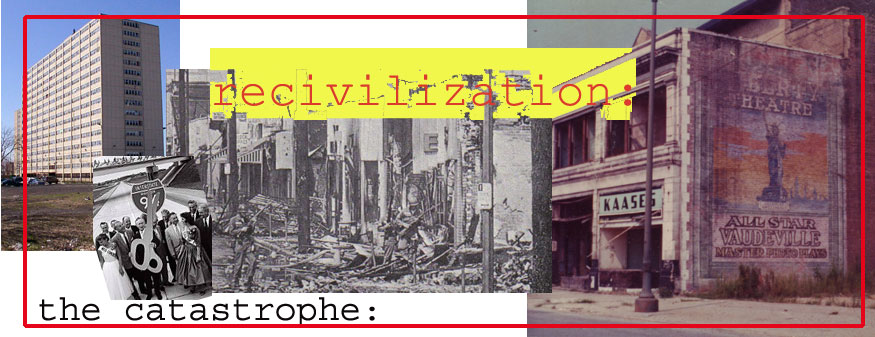

330 the left hand and the rightIt is our goal to reconstruct the physical and social fabric of the American urban environment Somehow, all the enormous effort involved in urban renewal, public housing and the other programs did not seem to be having the desired results. After 1960, a fresh rush of enthusiasm came in with the Kennedy administration and its team of cutting-edge technocrats. Many of these were corporate types, like Robert McNamara of Ford, and they had plenty of scientistic ideas about solving the nation's problems with their 'systems analysis' and 'mission-oriented problem solving'. These men brought the same approach to cities that was to work so brilliantly in Vietnam. And they used the same language in describing the fight. Hear Hubert Humphrey railing against slums: 'We simply must declare war on this evil, just as we have on Communist aggression.' In 1962, Kennedy called for the creation of a new cabinet department to consolidate the government's proliferating urban programs. The necessary legislation did not get passed until 1965, after the first riots frightened Congress into action; the Department of Housing and Urban Development set up shop the same year under the first black cabinet member in U.S. history, Robert Weaver. In an atmosphere of bright-eyed optimism and can-do spirit, HUD promised to make the dream of planners and reformers since the 1920's come true. Its first major initiative was a program called Model Cities, which has become something of a legend among people who study public policy. Supposedly a comprehensive attack on all sorts of urban ills in a few of the worst big-city neighborhoods, with the widest possible citizen participation, it turned out to be a program where just about anything was possible, especially after Congress expanded it to every important member's home town (Helena, Montana, McAlester, Oklahoma, and Texarkana, Texas were in the first round). Offices were opened, and funds shifted between them; blue-and-orange signboards proclaiming future progress appeared on every conspicuous vacant lot. In Gary, Indiana, the government spent over $3,000 per citizen. But no hint of an improvement was detected in any neighborhood; what exactly happened in Model Cities, and where the billions really went, will never be known. Another pillar of the Kennedy-Johnson effort was the Office of Economic Opportunity, mandated by the Economic Opportunity Act of 1964. The height of folly in the War on Poverty came when the OEO, under Sargent Shriver, started organizing radical opposition groups under the noses of outraged city mayors. 'Community action' theories were the rage at the universities; the government itself would organize the grass roots to fight for their rights, and natural leaders would emerge to carry on the struggle. As it turned out, the OEO had a political agenda of its own, and its organizing efforts were directed mainly towards building a power base it could use to increase its funding and influence within the government. The government men got jived. The OEO gave nearly a million to a savvy Chicago gang called the Blackstone Rangers, for a 'training program', and it helped them get another pile from the Ford Foundation. The Black Panther Party was founded inside one of its Community Action Agency offices in Oakland. In Cleveland, gang leader Fred Ahmed Evans took their money for a job program and used it to buy guns; he started the 1968 Glenville shootout, and the subsequent riot. Lyndon Johnson had put a great deal of faith in the experts, and he realized only too late what they had done to him. They say Johnson once sent off a memo with a note penciled in the margin: 'Who thought up this Great Society anyhow?' Johnson was soon gone, but a national consensus for raising up the poor and fixing cities still existed. A second, bigger Great Society rolled in right behind the first—the Nixon administration. Nixon's two terms saw the real consolidation of the welfare state, with big increases in ADC, food stamps, subsidized housing programs, jobs and job training, and plain cash giveaways, the 'Urban Development Action Grants'. At the same time, following the much-misunderstood 'benign neglect' counsel of Patrick Moynahan, he studiously avoided the politically contentious problems of housing discrimination and school integration. In his first term, Nixon started to weed out the worst clinkers among the programs, notably the OEO, urban renewal and public housing construction. To replace public housing, however, the HUD planners gave him another bright lemon of a program. 'Section 235' (of the 1968 Housing Act) has been called 'the greatest housing scandal in history'. On paper, it seemed like a promising and very progressive idea. To increase homeownership among low-income people, the FHA (now part of HUD) would guarantee mortgages for them, just as it had always done for middle and upper-class families. In practice, Section 235 rapidly turned into a nightmare of criminal collusion between HUD field officials and local speculators. Homes, many of them wrecks, would be given a few cosmetic improvements. HUD men then made inflated appraisals, in return for payoffs, and the homes were sold at ridiculous prices-but with very low down payments. As they deteriorated, families unable to make necessary repairs would just walk away from them. Other families, unprepared for homeownership or simply facing money troubles, took the same way out, while some who had to move and tried to re-sell their homes found themselves with negative equity; they walked away too, and HUD got to keep the house. Often the house could be recycled, to work the scam over again on another unsuspecting family. This is how Detroit in the mid-70's got 17,000 abandoned houses with HUD possession notices nailed to their doors. In every other city, while the total numbers may not have been quite as impressive, the result was the same (and we haven't even mentioned 'Section 236', which had the same disastrous effect on multi-family buildings). All through the 70's and 80's neighborhood groups had to spend much of their time and effort cleaning up after HUD, compiling lists of abandoned buildings ('OVVs' as we called them, for 'open, vacant and vandalized') and pushing overworked city housing departments to get them demolished. It could try the soul at times, working to keep up a neighborhood when every block was sprouting OVV's and vacant lots, gifts from Uncle Sam. As the neighborhoods rotted, most people driving through concluded that they were dying a natural death, that conditions had become so bad that no one could stand to live in them any more. It would have been a difficult conceptual leap, in those days, to understand that these streets were instead victims of a federal government that had made itself the nation's biggest and most vicious slumlord. While Washington vaunted its campaign to save 'troubled cities', while well-meaning officials and academics continually restated their hopes and plans for them, nearly no one saw that Washington, far from being the savior of cities, was in fact the major factor behind all of their problems. With the one hand, the government poured in money for ever bigger and more destructive programs. With the other, it raped cities with highways, urban renewal, public housing, the promotion of industrial decentralization and the massive subsidizing of suburban development. Can it be surprising that so few could see the real picture, when the government itself did not realize what it was doing? |
|

|